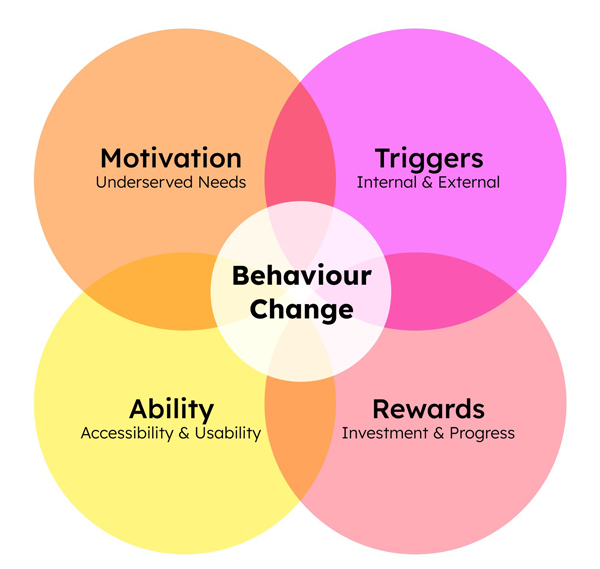Designing for behaviour change: The key to success in digital health

As discussed at the recent World Without Disease Summit, our lifestyle, environment, society, and even biology often work against us. We feel like we've been forced down a path against our will, and our biases can make it hard for us to foresee transformative change.
Challenging societal norms and getting support from public health institutions are crucial for driving behaviour change and fostering the adoption of digital health solutions. By addressing barriers, leveraging behaviour change theories, and promoting accessibility and equity, digital health solutions can have a transformative impact on individuals' behaviours and the overall health of communities.
A misconception is that digital health products will naturally be accessible and easier to adopt, as it is right here, at our fingertips, on our phone. Unfortunately, creating new habits can mean breaking a bad one first. Many brands compete for our attention nowadays and want us to become “obsessed” with their products, even to the detriment of our health. Having DTx on your phone also means competing with everything else on your phone. Some apps have created strong, long-lasting bonds that trump the need for better health.
What makes a behaviour change?
Behavioural science is key to shaping new behaviours, but it can be complex to navigate and apply. The Fog behaviour model,1 popularised by Nir Eyal in his book "Hooked", is probably the easiest way to explain how a behaviour change can be achieved in digital products:

Let's take the example of answering a phone call to illustrate this idea:
Lacking motivation – You've reached for your phone, but the number is unknown, or someone you don't want to talk to.
Lacking ability – You want to answer, but your phone is buried in the sofa, and you can't find it.
Missing triggers – You didn't even notice your phone ringing, as it was on silent.
When we think about digital health products, the efficacy of these solutions is intimately linked to the quality of the user experience. Many DTx will have failed to demonstrate efficacy during clinical trials, due to poor engagement, usability, and user experience. Your treatment isn’t bad; the user interface is. If your product were a pill, it would be the size of a football, and nobody would know how to swallow it.
Motivation and triggers are the sources of all changes
The biggest task in behavioural change is identifying motivations and internal triggers. Underserved needs define motivation, while internal triggers are natural moments for your digital product to intervene.
Behaviours can be “nudged” using what is known as “nuggets” — a collection of documented behaviours that influence our decision-making. For example, Dynamic Norms2 tell us that we are more likely to adopt a new behaviour if we believe that a large group of people are embracing this new behaviour. The “default effect” tells us that we tend to accept the option pre-chosen for us, putting behaviour change into the hands of the system creators: you.
Before getting excited and applying all nudges within the design of your digital health product, you must understand that humans aren’t great at dealing with overwhelming stimulation and information. Too many nuggets can backfire in an allergic reaction to taking action. Those triggers need to be tested and adapted to apply to your audience.
Nudging without pushing
In Thinking, Fast and Slow, Daniel Kahneman divides our decision-making into systems 1 and 2. System 1 operates automatically and quickly, with little or no effort and limited rationalisation. While System 2 allocates attention to the high-effort mental activities that demand it, including complex computations. The issue is that System 2 increases cognitive load, and we will default to System 1 when possible, especially with emotionally loaded choices.
In early interventions, when presented with an external trigger, such as notifications, reminders, text messages, or onboarding, we make fast, reactionary System 1 judgements to preserve our cognitive load. Making it as easy as possible to complete an action is crucial to avoid the dreaded "I don't have the mental capacity to work this out now", which leaves a long-lasting emotional memory of a negative experience or even leads to misuse of your products. Pertinent timing and effortless ability to act are key to early adoptions and creating change.
Sustaining change through investments and rewards
Adoption during early interventions might be triggered by motivation and underserved needs, but engagement and retention happen through a personal investment and reward feedback loop in your product. The more we invest in a solution, the more we value its capacity to improve our lives, making it hard for people to switch to another solution.
Unfortunately, we easily get bored of the same experience, and variable rewards are key to building habits. The reward is demonstrated by the evidence of change, a sense of progress on our journey.3 Investment of time can be seen in products that improve insights when providing regular data points. Social platforms are great examples of this, where algorithms reward users for their engagement with the platform. The more you give, the more visible you get, which drives increased social reward.
Gamify everything? Not that simple…
Gamification isn't about games and badges, especially in healthcare — it is about progress. Progress is key in creating a habit, demonstrating how close people are to becoming their new selves. Rather than rewarding users for how often they’ve used the product, demonstrate how much they’ve personally changed. Reflection on progress is a great way to benchmark improvements, offering milestones to see changes or personalising the user experience based on their usage.
The challenge of some chronic diseases is that people want to spend less time thinking about it; therefore, engaging less is a valid goal. By contrast, some sports health apps have the opposite goal; the more you invest, the more you get out of them (Fitbit). You must be mindful of people's mental models, as one size doesn't fit all.
Type 1 and type 2 diabetes are good examples. If you invest time and effort, you can reverse type 2 diabetes, so gamification using rewards and triggers can be a strong positive reinforcement when combined with visible change. In contrast, people living with type 1 diabetes want to reduce its impact on their life as much as possible; investing time is the opposite of making it disappear. Motivation is so strong that some people will hack their pump to automatically deliver insulin4 using open-source software.5 They are mindful that bypassing a safety guard by manually setting the pump can be dangerous, but the benefits of living without thinking about diabetes outweigh the risks.
Understanding motivations to create an efficient feedback loop and triggers that will bring satisfaction is critical.
Where should you prioritise your effort to change behaviours?
This will depend on your digital product's maturity, strength, and weaknesses. A cyclical iterative process of Insight-Test-Learn is crucial to maximising your chances of success.
Invest in understanding motivations at the early stages of your product definition when looking for product-market fit, as it is essential to building scalable digital products. You should also increase focus on motivation when your matured product lacks retention. Motivation will be the most expensive, time-consuming, and challenging aspect of your digital product, but getting it right will be the difference between success and failure.
Increasing your audience's ability to act is the investment with the quickest ROI. Invest in usability and UX design before clinical trials or FDA approval, as this is closely linked to the efficacy of your digital product. Reducing the effort required to take action will instantly increase access to those that already have the motivation to change their habits.
References
https://behaviormodel.org/
https://www.coglode.com/nuggets/dynamic-norms
https://medium.com/choice-hacking/goal-gradient-effect-how-rewards-can-improve-your-customer-experience-25dfcab5e3b8
https://www.drugtopics.com/view/hacking-diabetes-the-diy-bionic-pancreas-is-here-to-stay
https://loopkit.github.io/loopdocs/













